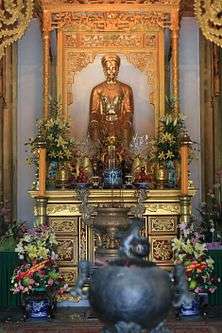Huyền Trân
Princess Huyền Trân (Vietnamese: Huyền Trân Công Chúa, 玄珍公主) (1289-after 1330?) later Queen Paramecvariin of Champa, was a princess during the Trần Dynasty in the history of Vietnam.

Biography
She was the daughter of Emperor Trần Nhân Tông[1]:211 and the younger sister of Emperor Trần Anh Tông. There are few details in the historical record about princess Huyền Trân's life. She was born in 1289 but her year of death is unclear. In 1293 Emperor Trần Nhân Tông abdicated in favor of his son, Trần Anh Tông, in order to join a monastery in a pagoda on Mount Yen Tu in what is now Quảng Ninh Province.
In 1301, the Emperor's father, Trần Nhân Tông, visited the Champa kingdom and was given a lavish royal welcome by King Jaya Sinhavarman III. The visit lasted nine months. When Trần Nhân Tông left Champa for Đại Việt (the name of Vietnam at the time), he promised to give his daughter in marriage to king Jaya Sinhavarman III even though the Cham king was already married and that Cham queen was a Javanese named Tapasi. Jaya Sinhavarman III thereafter sent many envoys to Đại Việt to urge the Trần King to carry out the marriage plan as Trần Nhân Tông had promised but the Emperor refused. Among the Emperor's men, only General Văn Túc Đạo Tái and Minister Trần Khắc Chung supported the marriage.
In 1306 Jaya Sinhavarman III offered to cede the two Cham provinces of Chau O and Chau Ly as a dowry and Trần Anh Tông finally agreed to give his sister in marriage to the Cham king. In 1306 Trần Anh Tông married off princess Huyền Trân to the Champa King Jaya Sinhavarman III (Vietnamese: Chế Mân, 制旻) and as Queen Paramecvariin of Champa, in return for the two provinces of Chau O and Chau Ly (or Chau Ri) (today these provinces are Quảng Bình Province, Quảng Trị Province and Thừa Thiên–Huế Province).[2][3]
Princess Huyền Trân went to Champa but a year later, in May 1307, Jaya Sinhavarman III died and the crown prince sent an ambassador to Đại Việt to offer white elephants as gifts and announced the death of his king. According to Cham tradition, all of the royal wives would be cremated with the dead king. King Trần Anh Tông ordered a general named Trần Khắc Chung to go to Champa to officially attend the funeral but the real mission was for Trần Khắc Chung to rescue Huyền Trân and take her back to Đại Việt by boat. The trip back took a year. Legends had it that Trần Khắc Chung fell in love with Princess Huyền Trân and the two disappeared from sight together but there is no historical proof to back up this story.
Huyền Trân in art
The sacrifice of princess Huyền Trân (well known in Vietnamese literature and history as "Huyền Trân Công Chúa") has become an attractive topic for poems and arts and music in Vietnamese chữ Nôm.[4] Her marriage is also proverbial.[5]
- Play Huyên Trân công chúa (Princess Huyền Trân) by Đoàn Thanh Ái[6]
- Poems: Princess Huyền Trân by Hoàng Cao Khải, and Farewell to Huyền Trân by Đào Tiến Luyện
- Music: Epic of the Mandarin Road,
- Farewell to Huyền Trân by Đào Tiến Luyện, set to music by Phạm Duy,
- Princess Huyền Trân by musician Nguyễn Hiền,
- Missing by musician Châu Kỳ,
- Love story of Huyền Trân by Nam Lộc,
- Hard life in Champa (folklore song).
Most cities in Vietnam have named major streets after her.[7]
References
- Coedès, George (1968). Walter F. Vella (ed.). The Indianized States of Southeast Asia. trans.Susan Brown Cowing. University of Hawaii Press. ISBN 978-0-8248-0368-1.
- Bruce M. Lockhart, William J. Duiker Historical Dictionary of Vietnam republished The A to Z of Vietnam 2010 Page 172 "Huyền Trân... A 14th-century princess of the Trần dynasty who was the center of an abortive attempt at marriage diplomacy between Vietnam and Champa. Promised in marriage to the Cham ruler by her father, the retired Emperor Trần Anh Tông, Huyén Trân..."
- Dông Phong Monts et merveilles au pays du Bois d'Aigle 2009 Page 44 "...Trần Anh Tông en échange de la main de la sœur de ce dernier, la princesse Trần Huyền Trân."
- Văn Kiễm Thái La Princesse Huyền-Trân et l'influence sino-chàme sur la musique 1950
- Mille et un proverbes Vân Hoà - 2011 Page 25 "En voici une qui fait clairement allusion au mariage de la Princesse Huyền Trân avec le roi cham Chê Mân en 1306 et qui n'a pas la faveur, semble-t-il, du grand public : Tiếc thay hột gạo trắng ngần Đã vo nước đục lại vò lửa rơm."
- Đình Quang Vietnamese theater 1999 Page 100 "Such recent plays as Ðông tiền Vạn Lịch (Vạn Lịch Coin) by Trung Đông and Bùi Vũ Minh, Khúc hát tinh dời (Love'Song) by Liêu Nguyễn and Huyên Trân công chúa (Princess Huyền Trân) by Đoàn Thanh Ái are Worthy of mention."
- Vietnam Country Map. Periplus Travel Maps. 2003. ISBN 0-7946-0070-0.